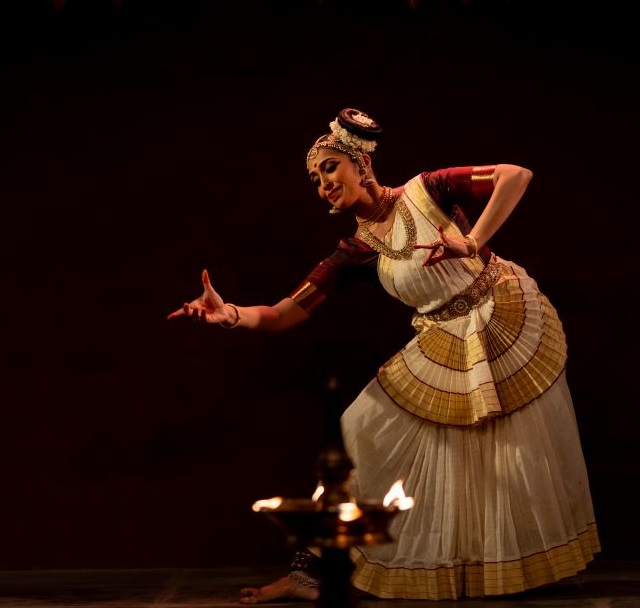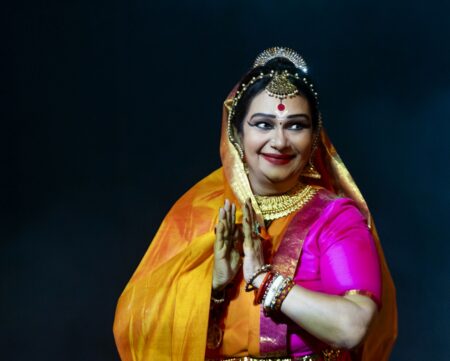Solo Mohiniyattam recital by Ameena Shanavas touched hearts for its sincerity.
The Kottichetham Studio Theatre at Natanakairali in Irinjalakkuda is a space like no other. Inspired by the tenets of traditional theatre architecture, the oblong auditorium with its exposed brickwork, wood and antique columns has a timeless grace. Open from three sides, the naturally ventilated space welcomes all without distinction – man, animal, bug or bird. It was in this welcoming space that Mohiniyattam dancer Ameena Shanavas, a disciple of Guru Nirmala Panicker staged her recital.
The theatre had just hosted ‘Arangunarthal’, a two-day festival featuring Rudraveena artist Bahauddin Dagar, Carnatic vocalist TM Krishna and a rare performance of Mudiyettu to celebrate its reopening after refurbishment. Ameena’s debut Mohiniyattam solo – ‘Saparya’ was the first dance recital here.
A long journey
Ameena started Mohiniyattam in 2002 under dancer Shyamala Surendran, and later joined Natanakaishiki in 2019, inspired by Guru Nirmala Panicker’s Kalari. Hailing from an orthodox family, Ameena’s love for Indian classical dance was always met with raised eyebrows and questions from the community. For most of her career as a dancer, she would sneak away to classes and recitals and never gave her performances any publicity.

It was her mother who enrolled her in a Bharatanatyam class when she was four. Her father, late Congress leader and Member of Parliament MI Shanavas, encouraged her to pursue her passion well into her adulthood, on the condition that she would be discreet about it. Motivated by her husband, Mohammed Hanish IAS, Principal Secretary (Health), and their daughter Ayesha, Ameena took a bold step forward to organize a public performance, ‘Saparya’ and invite close family members, some of whom had never seen her perform.
Saparya – A prayer
According to Nirmala Paniker’s bani, a margam from Cholkettu to Saptam connects with panchabhoota aaraadhana, veneration of the five elements, the result of which is aanandam experienced by the dancer and rasa relished by the spectators.
Opening with a Ganapathi stuti in Hamsadhwani, Ameena danced with precise execution of rhythm and technical perfection of adavus. Her practice and flexibility were evident in the controlled movements of her long limbs and torso. A stand-out moment from the piece was her adorable depiction of little Ganapathi enjoying his modakam.
A ragamalika talamalika Cholkettu came next, a composition with shlokas of bhagavati and shiva bookending a series of korvais.
Ameena was in her element by the third item, a Jatiswaram in Hamsadhwani ragam, Adi talam. While she showed her technical prowess in the first two, it was missing a certain je ne sais quoi, which she found in the Jatiswaram. Moving with ease and joy, Ameena’s contagious enthusiasm percolated to the audience.

The varnam ‘Geethayodhiya Govindan’ in Saaramathi ragam, adi talam followed next. The composition in praise of Vishnu highlighted two episodes from the life of Krishna, the deity’s most beloved avatar. First, he motivates Arjuna to uphold dharma by raising arms against his kin in the Kurukshetra war and second, he comes to Draupadi’s rescue in the Kaurava court. Speaking of Abhinaya, the battlefield episode lacked the gravitas it deserved while vastrakshepam, one of the most performed themes in classical dance, lacked nuance and freshness of perspective. Instead, it featured all the usual tropes – a weak and pleading Draupadi, a boisterous disrober in the form of Dusshasana and Krishna with reams of saree spurting out of his palm. The redeeming moments of the varnam came during Ameena’s illustration of the dasavataaram, particularly her ferocious portrayal of Narasimha.
The padam Varika Varika written by Guru Kalyanikutty Amma failed to connect despite a promising start. The lilting composition in Ananda bhairavi perfectly sets the scene for the nayika who eagerly awaits the return of her sakhi with news from Krishna. However, the narrative was fractured when the dancer plunged into a side story of Krishna lifting the Govardhan mountain, spending too long painting the picture of characters caught in the torrential rain. While the Natanakaishiki bani is known for its pakarnnattam and bhakti content, in a love ballad, one would have liked to see more of the nayika and immerse in her feelings of longing.
At the end of the uplifting thillana in Bhoopalam one naturally expected the recital to conclude but surprisingly there was more. The add-on segment opened with the celebrated verse Shive shringaraadra from Adi Shankaracharya’s Soundarya Lahari. Ameena’s involvement was evident from the get-go as she navigated the ashta rasas of Devi.
The recital ended with Chandanam, a forgotten desi choreography that used to be part of the Mohiniyattam repertoire in its early history. The piece gained momentum when she depicted Shiva’s dilemma on drinking the kalakoota poison that emerges from the churning of the milky ocean. Parvathi prevents him from swallowing it by placing her hand on his throat and Vishnu stops him from spitting it out by sealing his mouth. Expertly switching between the characters – Parvathi, Shiva and Vishnu, Ameena created dramatic tension and held the spectators’ attention. The story finds a happy resolution when Parvathi revives the fallen Shiva with sandalwood paste from Vishnu’s chest.
A surprising moment in the choreography was when the dancer broke the fourth wall to offer sandalwood paste to members of the audience.
The two-and-a-half-hour katcheri felt lengthy, even for enthusiasts. Accompanying her was an ensemble of musicians with Neelamperoor Sureshkumar (vocal), Murali Krishnan,( Veena) Vivek Shenoy (Flute), Kalanilayam Prakashan (Madhalam), Kalanilayam Ramakrishnan(Idakka) and Sandra Pisharody (Nattuvangam).
True to its name, Saparya was a prayer indeed. Ameena’s humble and sincere prayer to dance, her guru, and above all, her dad whom she misses every day.
Photo credit: Tulasi Kakkat, Haree Fotografie




